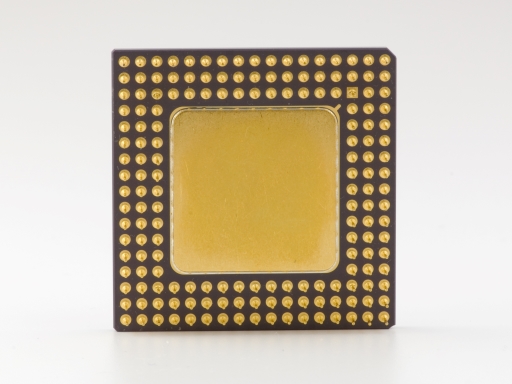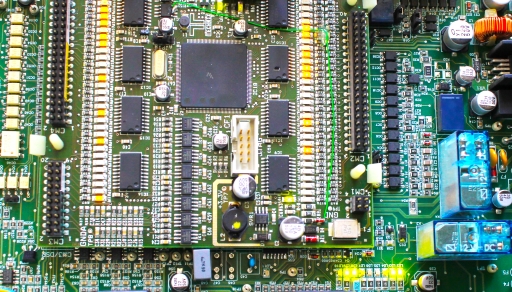2 What does a processor look like?
So, what do these devices that are manufactured in such vast quantities look like? Processors are manufactured as integrated circuits. Essentially, they are electronic circuits, around the size of a fingernail, which contain many millions of electronic components manufactured as one very complex circuit. Figure 1 shows how a processor manufactured as an integrated circuit is packaged so it can be used as a component in an electronic circuit. The processor is surrounded with pins to connect to the integrated circuit using gold bonding wire. (Gold is most commonly used, but sometimes aluminium is used instead.) Some of the pins are used to supply the electrical power to the device, while signals are input to and output from the processor via other pins.
Figure 2 shows the packaged processor assembled with other components on the motherboard of a computer. A motherboard is the major circuit board inside a computer: it holds the processor, the computer bus, the main memory and many other vital components.
A processor is essentially a single integrated circuit that contains the central processing unit (CPU) of a computer. The CPU can be thought of as the command centre of the computer; amongst other functions, it interprets each program’s instructions and organises the storage and retrieval of the data involved. Developing the CPU into a single component has considerable benefits, including reduced manufacturing and running costs and the potential to manufacture in very large numbers. The CPU can then be placed on a single circuit board, the motherboard, along with other key components such as memory. Bringing the components together allows the computer to work more efficiently as well as bringing down the cost of manufacture.
The processor runs at a set speed, its clock speed. This is measured in gigahertz (GHz). Hertz is the number of cycles (actions) per second, and the giga prefix multiplies that by a billion. This means that a processor rated at 2.2 GHz, completes 2,200,000,000 cycles per second. This clock is the speed that everything happens in your computer, such as performing a calculation and retrieving data from your hard-drives, all controlled and synchronized by your processor. Clock speed can be a very important measure in some situations, for example in scientific computing where there are many calculations for the processor to perform. However, the processor speed will probably be less critical on your laptop, for example, where the processor will spend much time waiting for you to enter data via the keyboard, or to retrieve a page from the internet.
Processors have been getting faster, but the real growth in processor performance has been achieved by a different method. In the next section, you will look at a particular example of how more and more components have been brought closer and closer together to achieve greater overall computing performance.


